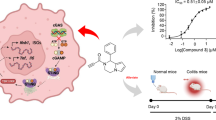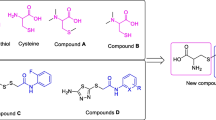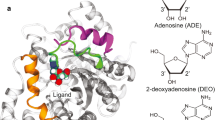Abstract
Carboxypeptidase G2 (CPG2) is a bacterial enzyme widely used to detoxify methotrexate (MTX) and in enzyme/prodrug therapy for cancer treatment. However, several drawbacks, such as instability, have limited its efficiency. Herein, we have evaluated the properties of a putative CPG2 from Acinetobacter sp. 263903-1 (AcCPG2). AcCPG2 is compared with a CPG2 derived from Pseudomonas sp. strain RS-16 (PsCPG2), available as an FDA-approved medication called glucarpidase. After modeling AcCPG2 using the I-TASSER program, the refined model was validated by PROCHECK, VERIFY 3D and according to the Z score of the model. Using computational analyses, AcCPG2 displayed higher thermodynamic stability and a lower aggregation propensity than PsCPG2. AcCPG2 showed an optimum pH of 7.5 against MTX and was stable over a pH range of 5–10. AcCPG2 exhibited optimum activity at 50 °C and higher thermal stability at a temperature range of 20–70 °C compared to PsCPG2. The Km value of the purified AcCPG2 toward folate and MTX was 31.36 µM and 44.99 µM, respectively. The Vmax value of AcCPG2 for folate and MTX was 125.80 µmol/min/mg and 48.90 µmol/min/mg, respectively. Accordingly, thermostability and pH versatility makes AcCPG2 a potential biobetter variant for therapeutic applications.






Similar content being viewed by others
References
Rowsell, S., Pauptit, R. A., Tucker, A. D., Melton, R. G., Blow, D. M., & Brick, P. (1997). Crystal structure of carboxypeptidase G2, a bacterial enzyme with applications in cancer therapy. Structure, 5(3), 337–347.
McCullough, J. L., Chabner, B. A., & Bertino, J. R. (1971). Purification and properties of carboxypeptidase G1. Journal of Biological Chemistry, 246(23), 7207–7213.
Green, J. M. (2012). Glucarpidase to combat toxic levels of methotrexate in patients. Therapeutics and Clinical Risk Management, 8, 403.
Minton, N. P., Atkinson, T., Bruton, C. J., & Sherwood, R. F. (1984). The complete nucleotide sequence of the Pseudomonas gene coding for carboxypeptidase G2. Gene, 31, 31–38.
Sherwood, R. F., Melton, R. G., Alwan, S. M., & Hughes, P. (1985). Purification and properties of carboxypeptidase G2 from Pseudomonas sp. strain RS-16: Use of a novel triazine dye affinity method. European Journal of Biochemistry, 148(3), 447–453.
Goda, S. K., Rashidi, F. A. B., Fakharo, A. A., & Al-Obaidli, A. (2009). Functional overexpression and purification of a codon optimized synthetic glucarpidase (carboxypeptidase G2) in Escherichia coli. The Protein Journal, 28(9), 435–442.
Trifilio, S., Ma, S., & Petrich, A. (2013). Reduced-dose carboxypeptidase-G2 successfully lowers elevated methotrexate levels in an adult with acute methotrexate-induced renal failure. Clinical Advances in Hematology & Oncology, 11(5), 322–323.
Bayineni, V. K., Venkatesh, K., Sahu, C. K., & Kadeppagari, R. K. (2016). The 46 kDa dimeric protein from Variovorax paradoxus shows faster methotrexate degrading activity in its nanoform compare to the native enzyme. Enzyme and Microbial Technology, 85, 38–43.
Jeyaharan, D., Aston, P., Garcia-Perez, A., Schouten, J., Davis, P., & Dixon, A. M. (2016). Soluble expression, purification and functional characterisation of carboxypeptidase G2 and its individual domains. Protein Expression and Purification, 127, 44–52.
Marais, R., Spooner, R. A., Light, Y., Martin, J., & Springer, C. J. (1996). Gene-directed enzyme prodrug therapy with a mustard prodrug/carboxypeptidase G2 combination. Cancer Research, 56(20), 4735–4742.
Bhatia, J., Sharma, S. K., Chester, K. A., Pedley, R. B., Boden, R. W., Read, D. A., & Begent, R. H. (2000). Catalytic activity of an in vivo tumor targeted anti-CEA scFv: Carboxypeptidase G2 fusion protein. International Journal of Cancer, 85(4), 571–577.
Jamin, Y., Smyth, L., Robinson, S. P., Poon, E. S., Eykyn, T. R., Springer, C. J., & Payne, G. S. (2011). Noninvasive detection of carboxypeptidase G2 activity in vivo. NMR in Biomedicine, 24(4), 343–350.
Capucha, V., Mendes, E., Francisco, A. P., & Perry, M. J. (2012). Development of triazene prodrugs for ADEPT strategy: New insights into drug delivery system based on carboxypeptidase G2 activation. Bioorganic & Medicinal Chemistry Letters, 22(22), 6903–6908.
Karjoo, Z., Chen, X., & Hatefi, A. (2016). Progress and problems with the use of suicide genes for targeted cancer therapy. Advanced Drug Delivery Reviews, 99, 113–128.
Rashidi, F. B., AlQhatani, A. D., Bashraheel, S. S., Shaabani, S., Groves, M. R., Dömling, A., & Goda, S. K. (2018). Isolation and molecular characterization of novel glucarpidases: Enzymes to improve the antibody directed enzyme pro-drug therapy for cancer treatment. PloS One, 13(4), e0196254.
AlQahtani, A. D., Al-Mansoori, L., Bashraheel, S. S., Rashidi, F. B., Al-Yafei, A., Elsinga, P., & Goda, S. K. (2019). Production of “biobetter” glucarpidase variants to improve drug detoxification and antibody directed enzyme prodrug therapy for cancer treatment. European Journal of Pharmaceutical Sciences, 127, 79–91.
Brumano, L. P., da Silva, F. V., Costa-Silva, T. A., Apolinário, A. C., Santos, J. H., Kleingesinds, E. K., Monteiro, G., Rangel-Yagui, C. D., Benyahia, B., & Junior, A. P. (2019). Development of L-asparaginase biobetters: Current research status and review of the desirable quality profiles. Frontiers in Bioengineering and Biotechnology. https://doi.org/10.3389/fbioe.2018.00212
Barbosa, M. D., Kumar, S., Loughrey, H., & Singh, S. K. (2012). Biosimilars and biobetters as tools for understanding and mitigating the immunogenicity of biotherapeutics. Drug Discovery Today, 17, 1282–1288.
Kesik-Brodacka, M. (2018). Progress in biopharmaceutical development. Biotechnology and Applied Biochemistry, 65(3), 306–322.
Sadeghian, I., Rezaie, Z., Rahmatabadi, S. S., & Hemmati, S. (2020). Biochemical insights into a novel thermo/organo tolerant bilirubin oxidase from Thermosediminibacter oceani and its application in dye decolorization. Process Biochemistry, 88, 38–50.
Rahmatabadi, S. S., Sadeghian, I., Nezafat, N., Negahdaripour, M., Hajighahramani, N., Hemmati, S., & Ghasemi, Y. (2017). In silico investigation of pullulanase enzymes from various Bacillus species. Current Proteomics, 14(3), 175–185.
Wadhwani, S. A., Shedbalkar, U. U., Singh, R., & Chopade, B. A. (2018). Biosynthesis of gold and selenium nanoparticles by purified protein from Acinetobacter sp. SW 30. Enzyme and Microbial Technology, 111, 81–86.
Lee, C. R., Lee, J. H., Park, M., Park, K. S., Bae, I. K., Kim, Y. B., Cha, C. J., Jeong, B. C., & Lee, S. H. (2017). Biology of Acinetobacter baumannii: Pathogenesis, antibiotic resistance mechanisms, and prospective treatment options. Frontiers in Cellular and Infection Microbiology, 7, 55.
Lakshmikanth, M., Manohar, S., & Lalitha, J. (2009). Purification and characterization of β-agarase from agar-liquefying soil bacterium, Acinetobacter sp., AG LSL-1. Process Biochemistry, 44(9), 999–1003.
Sikarwar, J., Kaushik, S., Sinha, M., Kaur, P., Sharma, S., & Singh, T. P. (2013). Cloning, expression, and purification of nucleoside diphosphate kinase from Acinetobacter baumannii. Enzyme Research. https://doi.org/10.1155/2013/597028
Wang, C. H., Zhao, T. X., Li, M., Zhang, C., & Xing, X. H. (2016). Characterization of a novel Acinetobacter baumannii xanthine dehydrogenase expressed in Escherichia coli. Biotechnology Letters, 38(2), 337–344.
Gururaj, P., Ramalingam, S., Devi, G. N., & Gautam, P. (2016). Process optimization for production and purification of a thermostable, organic solvent tolerant lipase from Acinetobacter sp. AU07. Brazilian Journal of Microbiology, 47(3), 647–657.
Stivala, A., Wybrow, M., Wirth, A., Whisstock, J. C., & Stuckey, P. J. (2011). Automatic generation of protein structure cartoons with Pro-origami. Bioinformatics, 27(23), 3315–3316.
Yang, J., Yan, R., Roy, A., Xu, D., Poisson, J., & Zhang, Y. (2015). The I-TASSER suite: Protein structure and function prediction. Nature Methods, 12(1), 7–8.
Xu, D., & Zhang, Y. (2011). Improving the physical realism and structural accuracy of protein models by a two-step atomic-level energy minimization. Biophysical Journal, 101(10), 2525–2534.
Heo, L., Park, H., & Seok, C. (2013). GalaxyRefine: Protein structure refinement driven by side-chain repacking. Nucleic Acids Research, 41(W1), W384–W388.
Laskowski, R. A. (2007). Enhancing the functional annotation of PDB structures in PDBsum using key figures extracted from the literature. Bioinformatics, 23(14), 1824–1827.
Laskowski, R. A., Jabłońska, J., Pravda, L., Vařeková, R. S., & Thornton, J. M. (2018). PDBsum: Structural summaries of PDB entries. Protein Science, 27(1), 129–134.
Wiederstein, M., & Sippl, M. J. (2007). ProSA-web: Interactive web service for the recognition of errors in three-dimensional structures of proteins. Nucleic Acids Research, 35, W407–W410.
Eisenberg, D., Lüthy, R., & Bowie, J. U. (1997). [20] VERIFY3D: Assessment of protein models with three-dimensional profiles. Methods in Enzymology, 277, 396–404.
Pucci, F., Kwasigroch, J. M., & Rooman, M. (2017). SCooP: An accurate and fast predictor of protein stability curves as a function of temperature. Bioinformatics, 33(21), 3415–3422.
Schymkowitz, J. W., Rousseau, F., Martins, I. C., Ferkinghoff-Borg, J., Stricher, F., & Serrano, L. (2005). Prediction of water and metal binding sites and their affinities by using the Fold-X force field. Proceedings of the National Academy of Sciences, 102(29), 10147–10152.
Zaharieva, N., Dimitrov, I., Flower, D. R., & Doytchinova, I. (2017). Immunogenicity prediction by VaxiJen: A ten year overview. Journal of Proteomics Bioinformatics, 10, 298–310.
Andreatta, M., & Nielsen, M. (2018). Bioinformatics tools for the prediction of T-cell epitopes. In J. Rockberg & J. Nilvebrant (Eds.), Epitope mapping protocols (pp. 269–281). Humana Press.
Song, J., Li, F., Leier, A., Marquez-Lago, T. T., Akutsu, T., Haffari, G., Chou, K. C., Webb, G. I., & Pike, R. N. (2018). PROSPERous: High-throughput prediction of substrate cleavage sites for 90 proteases with improved accuracy. Bioinformatics, 34(4), 684–687.
Rawlings, N. D. (2016). Peptidase specificity from the substrate cleavage collection in the MEROPS database and a tool to measure cleavage site conservation. Biochimie, 122, 5–30.
Conchillo-Solé, O., de Groot, N. S., Avilés, F. X., Vendrell, J., Daura, X., & Ventura, S. (2007). AGGRESCAN: A server for the prediction and evaluation of “hot spots” of aggregation in polypeptides. BMC Bioinformatics, 8(1), 1–17.
Sadeghian, I., Khalvati, B., Ghasemi, Y., & Hemmati, S. (2018). TAT-mediated intracellular delivery of carboxypeptidase G2 protects against methotrexate-induced cell death in HepG2 cells. Toxicology and Applied Pharmacology, 346, 9–18.
Behzadipour, Y., Sadeghian, I., Ghaffarian Bahraman, A., & Hemmati, S. (2021). Introducing a delivery system for melanogenesis inhibition in melanoma B16F10 cells mediated by the conjugation of tyrosine ammonia-lyase and a TAT-penetrating peptide. Biotechnology Progress, 37(1), e3071.
Bradford, M. M. (1976). A rapid and sensitive method for the quantitation of microgram quantities of protein utilizing the principle of protein-dye binding. Analytical biochemistry, 72, 248–254.
Hemmati, S., Schneider, B., Schmidt, T. J., Federolf, K., Alfermann, A. W., & Fuss, E. (2007). Justicidin B 7-hydroxylase, a cytochrome P450 monooxygenase from cell cultures of Linum perenne Himmelszelt involved in the biosynthesis of diphyllin. Phytochemistry, 68, 2736–2743.
Hameduh, T., Haddad, Y., Adam, V., & Heger, Z. (2020). Homology modeling in the time of collective and artificial intelligence. Computational and Structural Biotechnology Journal, 18, 3494.
Ceaglio, N., Etcheverrigaray, M., Kratje, R., & Oggero, M. (2010). Influence of carbohydrates on the stability and structure of a hyperglycosylated human interferon alpha mutein. Biochimie, 92(8), 971–978.
Al-Qahtani, A. D., Bashraheel, S. S., Rashidi, F. B., O’Connor, C. D., Romero, A. R., Domling, A., & Goda, S. K. (2019). Production of “biobetter” variants of glucarpidase with enhanced enzyme activity. Biomedicine & Pharmacotherapy, 112, 108725.
Khoramnia, A., Ebrahimpour, A., Beh, B. K., & Lai, O. M. (2011). Production of a solvent, detergent, and thermotolerant lipase by a newly isolated Acinetobacter sp. in submerged and solid-state fermentations. Journal of Biomedicine and Biotechnology. https://doi.org/10.1155/2011/702179
Ahmad, S., Raza, S., Uddin, R., & Azam, S. S. (2018). Comparative subtractive proteomics based ranking for antibiotic targets against the dirtiest superbug: Acinetobacter baumannii. Journal of Molecular Graphics and Modelling, 82, 74–92.
Rahmatabadi, S. S., Sadeghian, I., Ghasemi, Y., Sakhteman, A., & Hemmati, S. (2019). Identification and characterization of a sterically robust phenylalanine ammonia-lyase among 481 natural isoforms through association of in silico and in vitro studies. Enzyme and Microbial Technology, 22, 36–54.
Pramanik, K., Ghosh, P. K., Ray, S., Sarkar, A., Mitra, S., & Maiti, T. K. (2017). An in silico structural, functional and phylogenetic analysis with three dimensional protein modeling of alkaline phosphatase enzyme of Pseudomonas aeruginosa. Journal of Genetic Engineering and Biotechnology, 15(2), 527–537.
Behzadipour, Y., & Hemmati, S. (2019). Considerations on the rational design of covalently conjugated cell-penetrating peptides (CPPs) for intracellular delivery of proteins: A guide to CPP selection using glucarpidase as the model cargo molecule. Molecules, 24(23), 4318.
Pucci, F., & Rooman, M. (2014). Stability curve prediction of homologous proteins using temperature-dependent statistical potentials. PLoS Computational Biology, 10(7), e1003689.
Agrawal, N. J., Kumar, S., Wang, X., Helk, B., Singh, S. K., & Trout, B. L. (2011). Aggregation in protein-based biotherapeutics: Computational studies and tools to identify aggregation-prone regions. Journal of Pharmaceutical Sciences, 100(12), 5081–5095.
Rosenberg, A. S. (2006). Effects of protein aggregates: An immunologic perspective. The AAPS Journal, 8(3), E501–E507.
Kramer, R. M., Shende, V. R., Motl, N., Pace, C. N., & Scholtz, J. M. (2012). Toward a molecular understanding of protein solubility: Increased negative surface charge correlates with increased solubility. Biophysical Journal, 102(8), 1907–1915.
Prabakaran, R., Rawat, P., Thangakani, A. M., Kumar, S., & Gromiha, M. M. (2021). Protein aggregation: In silico algorithms and applications. Biophysical Reviews, 13, 71–89.
Li, W., Prabakaran, P., Chen, W., Zhu, Z., Feng, Y., & Dimitrov, D. S. (2016). Antibody aggregation: Insights from sequence and structure. Antibodies, 5(3), 19.
Ventura, S., Zurdo, J., Narayanan, S., Parreño, M., Mangues, R., Reif, B., Chiti, F., Giannoni, E., Dobson, C. M., Aviles, F. X., & Serrano, L. (2004). Short amino acid stretches can mediate amyloid formation in globular proteins: The Src homology 3 (SH3) case. Proceedings of the National Academy of Sciences, 101(19), 7258–7263.
De Groot, N. S., Aviles, F. X., Vendrell, J., & Ventura, S. (2006). Mutagenesis of the central hydrophobic cluster in Aβ42 Alzheimer’s peptide: Side-chain properties correlate with aggregation propensities. The FEBS Journal, 273(3), 658–668.
Viet, M. H., Ngo, S. T., Lam, N. S., & Li, M. S. (2011). Inhibition of aggregation of amyloid peptides by beta-sheet breaker peptides and their binding affinity. The Journal of Physical Chemistry B, 115(22), 7433–7446.
Pandey, R. K., Bhatt, T. K., & Prajapati, V. K. (2018). Novel immunoinformatics approaches to design multi-epitope subunit vaccine for malaria by investigating anopheles salivary protein. Scientific Reports, 8(1), 1–11.
Böttger, R., Hoffmann, R., & Knappe, D. (2017). Differential stability of therapeutic peptides with different proteolytic cleavage sites in blood, plasma and serum. PloS One, 12(6), e0178943.
Zhang, X. F., Yang, G. Y., Zhang, Y., Xie, Y., Withers, S. G., & Feng, Y. (2016). A general and efficient strategy for generating the stable enzymes. Scientific Reports, 6(1), 1–12.
Dantas, R. C., Caetano, L. F., Torres, A. L., Alves, M. S., Silva, E. T., Teixeira, L. P., Teixeira, D. C., de AzevedoMoreira, R., Fonseca, M. H., Neto, S. G., Martins, L. T., Furtado, G. P., & Tavares, K. C. S. (2019). Expression of a recombinant bacterial l-asparaginase in human cells. BMC Research Notes, 12(1), 1–6.
Frokjaer, S., & Otzen, D. E. (2005). Protein drug stability: A formulation challenge. Nature Reviews Drug Discovery, 4(4), 298–306.
Leuenberger, P., Ganscha, S., Kahraman, A., Cappelletti, V., Boersema, P. J., von Mering, C., Claassen, M., & Picotti, P. (2017). Cell-wide analysis of protein thermal unfolding reveals determinants of thermostability. Science. https://doi.org/10.1126/science.aai7825
Rosa, M., Roberts, C. J., & Rodrigues, M. A. (2017). Connecting high-temperature and low-temperature protein stability and aggregation. PloS One, 12(5), e0176748.
Kamal, M. Z., Ahmad, S., Molugu, T. R., Vijayalakshmi, A., Deshmukh, M. V., Sankaranarayanan, R., & Rao, N. M. (2011). In vitro evolved non-aggregating and thermostable lipase: Structural and thermodynamic investigation. Journal of Molecular Biology, 413(3), 726–741.
Taghizadeh, B., Taranejoo, S., Monemian, S. A., Salehi Moghaddam, Z., Daliri, K., Derakhshankhah, H., & Derakhshani, Z. (2015). Classification of stimuli–responsive polymers as anticancer drug delivery systems. Drug Delivery, 22(2), 145–155.
Acknowledgements
Authors would like to thank Shiraz University of Medical Sciences, Shiraz, Iran for the grant number 98-01-05-21235 and 18322.
Author information
Authors and Affiliations
Corresponding author
Ethics declarations
Conflict of interest
There are no conflicts of interest.
Additional information
Publisher's Note
Springer Nature remains neutral with regard to jurisdictional claims in published maps and institutional affiliations.
Supplementary Information
Below is the link to the electronic supplementary material.
Rights and permissions
About this article
Cite this article
Sadeghian, I., Hemmati, S. Characterization of a Stable Form of Carboxypeptidase G2 (Glucarpidase), a Potential Biobetter Variant, From Acinetobacter sp. 263903-1. Mol Biotechnol 63, 1155–1168 (2021). https://doi.org/10.1007/s12033-021-00370-3
Received:
Accepted:
Published:
Issue Date:
DOI: https://doi.org/10.1007/s12033-021-00370-3




